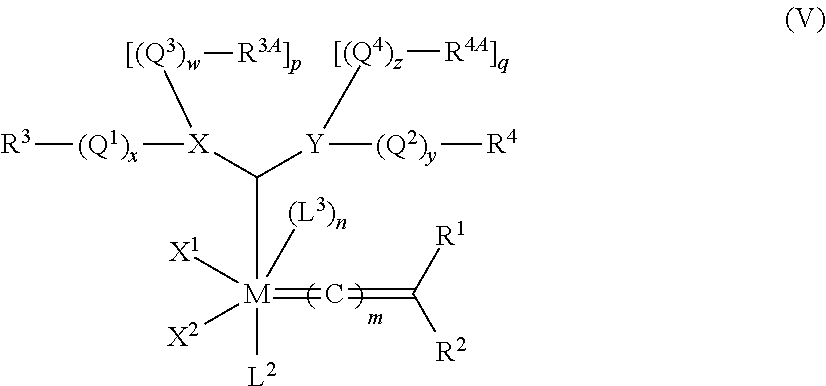Chemical methods for treating a metathesis feedstock
a technology of metathesis and feedstock, applied in the field of metathesis reactions, can solve the problems of affecting the efficiency of catalyst and metathesis reaction, and achieve the effect of reducing the starting peroxide value of feedstock
- Summary
- Abstract
- Description
- Claims
- Application Information
AI Technical Summary
Benefits of technology
Problems solved by technology
Method used
Image
Examples
example 1
[0172]In this example, the natural oil feedstock was chemically treated with sodium bisulfate to diminish the peroxides and additional non-peroxide catalyst poisons. The treatment began by filling a 3-neck 500 mL round bottom flask with 300 g feedstock of Fatty Acid Methyl Ester (FAME). Next, 0.83 wt % sodium bisulfate (JT Baker Lot #X37H17) was dissolved in 30 g of water and added to the feedstock. The feedstock was then stirred in the flask with an agitator. A nitrogen sparge began as the feedstock was heated to 60° C. The feedstock was held at 60° C. for at least 45 minutes to degas. The feedstock remained at 60° C. for an additional 90 minutes. Next, the feedstock was removed from the heating mantel and cooled down to 40° C. at which point the nitrogen sparge was stopped. The treated feedstock was then poured into a separation funnel. Approximately 300 mL of warm water was added to the feedstock. Then, the mixture was shaken vigorously to wash out and separate the treated feedst...
example 2
[0178]In this example, the natural oil feedstock was chemically treated with sodium borohydride to diminish the peroxides and additional non-peroxide catalyst poisons. The treatment began by filling a 3-neck 500 mL round bottom flask with 300 g feedstock of Fatty Acid Methyl Ester (FAME). Next, 0.291 g or 0.379 g sodium bisulfate (Aldrich Lot) was added to the flask, for examples MF-SBF6CO6 and MF-SBF6D22, respectively. The feedstock was then stirred in the flask with an agitator. A nitrogen sparge was started as the feedstock was heated to 80° C. The feedstock was held at 80° C. for at least 45 minutes to degas. The feedstock remained at 80° C. for an additional 2 hours. Next, 1.5 wt % magnesium silicate (Magnesol) and 1 wt % Celite were added to the flask. The feedstock was then removed from the heating mantel and cooled down to 40° C. at which point the nitrogen sparge was stopped. The treated feedstock was filtered through #4 paper on a Buchner funnel to separate the adsorbent f...
example 3
[0181]This example demonstrates, among other things, the presence of non-peroxide poisons in the feedstock. Soybean oil with a low peroxide value but no chemical treatment is compared with soybean oil that was chemically treated with sodium bisulfite. The results are displayed in Table 3.
TABLE 3metathesiscatalyststartingStart PVFinal PVtype of827materialValuevalueGC %FAME(ppm / db)treatment(meq / kg)(meq / kg)conversionSoy (Cargill)3None0.86—12Soy (Cargill)3None0.86—31Soy (Cognis)3Sodium10.50.958BisulfiteSoy (Cognis)3Sodium10.50.967Bisulfite
[0182]As shown in Table 3, a soybean oil feedstock with a low starting peroxide value (<1 meq / kg) and no chemical treatment led to a 12-31% conversion of the feedstock (or 17-44% conversion of the maximum theoretical limit, assuming a similar 70% conversion limit to the data in Example 1) at a catalyst loading of 3 ppm / db. In comparison, a different soybean oil feedstock treated with sodium bisulfite led to a similarly diminished peroxide value, but mu...
PUM
| Property | Measurement | Unit |
|---|---|---|
| temperature | aaaaa | aaaaa |
| temperature | aaaaa | aaaaa |
| temperature | aaaaa | aaaaa |
Abstract
Description
Claims
Application Information
 Login to View More
Login to View More - R&D
- Intellectual Property
- Life Sciences
- Materials
- Tech Scout
- Unparalleled Data Quality
- Higher Quality Content
- 60% Fewer Hallucinations
Browse by: Latest US Patents, China's latest patents, Technical Efficacy Thesaurus, Application Domain, Technology Topic, Popular Technical Reports.
© 2025 PatSnap. All rights reserved.Legal|Privacy policy|Modern Slavery Act Transparency Statement|Sitemap|About US| Contact US: help@patsnap.com



